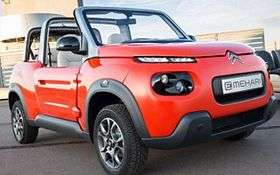Citroën E-Méhari
| Citroën E-Méhari | |
|---|---|
 | |
| Overview | |
| Manufacturer | Citroën |
| Production | 2016–present |
| Model years | 2017–present |
| Assembly | France: Rennes (Site de Rennes) |
| Designer | Pierre Authier |
| Body and chassis | |
| Class | Compact SUV |
| Body style | 2-door cabriolet |
| Layout | Front-engine, Front-wheel drive |
| Platform | Bluesummer |
| Related |
Bolloré Bluesummer Citroën C4 Cactus |
| Powertrain | |
| Electric motor | 50 kW [1] |
| Transmission | 1-speed fixed-gear [1] |
| Battery | 30 kWh lithium polymer [1] |
| Electric range |
200 km (120 mi) NEDC (urban) 100 km (62 mi) (extra-urban)[1] |
| Plug-in charging | 13 hours on home socket (10A), 8 hours on 16A [1] |
| Dimensions | |
| Wheelbase | 2,430 mm (95.7 in)[1] |
| Length | 3,809 mm (150.0 in)[1] |
| Width | 1,728 mm (68.0 in)[1] |
| Height | 1,653 mm (65.1 in)[1] |
| Curb weight | 1,405 kg (3,097 lb)[1] |
| Chronology | |
| Predecessor | Citroën Méhari |
The Citroën E-Méhari is an off-road compact SUV produced by the French car maker Citroën from 2016 onwards. About 1,000 cars are to be produced in collaboration with the French electric car producer Bolloré.[2] Sales began in France in spring 2016 with pricing starting at €25,000 excluding the battery leasing.[3] It reaches a top speed of 110 km/h and accelerates 0–50 km/h in 6.4 seconds.[1]
References
External links
| Wikimedia Commons has media related to Citroën E-Méhari. |
This article is issued from Wikipedia - version of the 11/24/2016. The text is available under the Creative Commons Attribution/Share Alike but additional terms may apply for the media files.